Attached files
| file | filename |
|---|---|
| 8-K - 8-K - WSFS FINANCIAL CORP | form8-k848017.htm |

WSFS Financial Corporation
2Q 2017 Investor Update
August 4, 2017
EXHIBIT 99.1

Stockholders or others seeking information regarding the Company may call or write:
WSFS Financial Corporation
Investor Relations
WSFS Bank Center
500 Delaware Avenue
Wilmington, DE 19801
302-571-7264
stockholderrelations@wsfsbank.com
www.wsfsbank.com
Mark A. Turner
President and CEO
302-571-7160
mturner@wsfsbank.com
Rodger Levenson
Chief Operating Officer
302-571-7296
rlevenson@wsfsbank.com
2
Dominic Canuso
Chief Financial Officer
302-571-6833
dcanuso@wsfsbank.com

Table of Contents
Forward-Looking Statements / Non-GAAP Information / Reported Financial Results
2017 Outlook & 2016 – 2018 Strategic Plan
The WSFS Franchise
Page 4
Page 10
Page 14
3
2Q 2017 Highlights Page 7
Selected Financial Information Page 25
Appendix 1 – Management Team Page 36
Appendix 2 – Business Model Page 38
Appendix 3 – Non-GAAP Financial Information Page 39
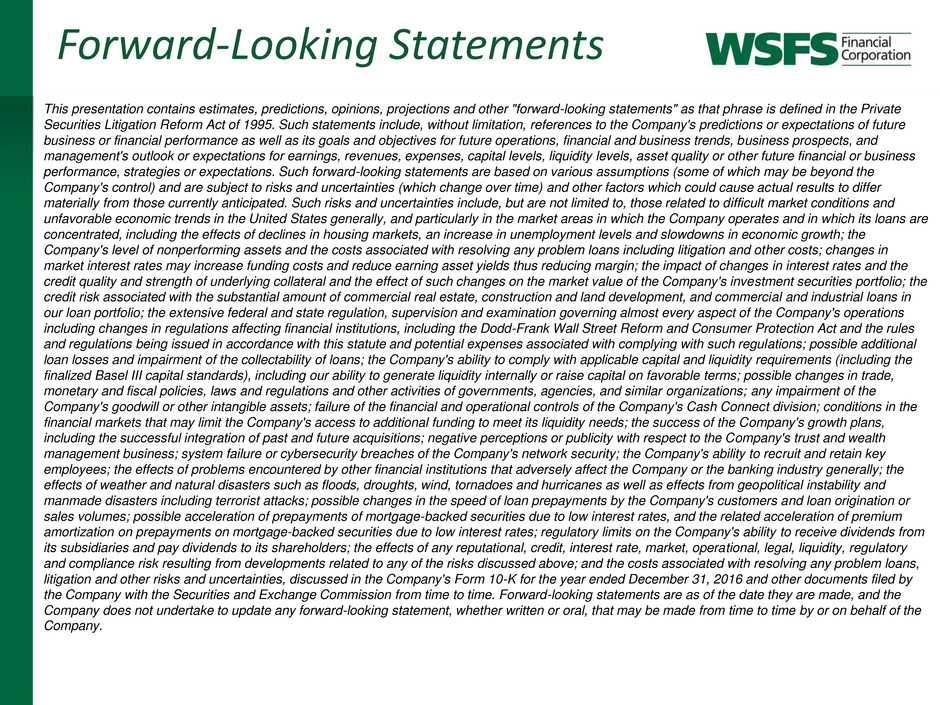
Forward-Looking Statements
This presentation contains estimates, predictions, opinions, projections and other "forward-looking statements" as that phrase is defined in the Private
Securities Litigation Reform Act of 1995. Such statements include, without limitation, references to the Company's predictions or expectations of future
business or financial performance as well as its goals and objectives for future operations, financial and business trends, business prospects, and
management's outlook or expectations for earnings, revenues, expenses, capital levels, liquidity levels, asset quality or other future financial or business
performance, strategies or expectations. Such forward-looking statements are based on various assumptions (some of which may be beyond the
Company's control) and are subject to risks and uncertainties (which change over time) and other factors which could cause actual results to differ
materially from those currently anticipated. Such risks and uncertainties include, but are not limited to, those related to difficult market conditions and
unfavorable economic trends in the United States generally, and particularly in the market areas in which the Company operates and in which its loans are
concentrated, including the effects of declines in housing markets, an increase in unemployment levels and slowdowns in economic growth; the
Company's level of nonperforming assets and the costs associated with resolving any problem loans including litigation and other costs; changes in
market interest rates may increase funding costs and reduce earning asset yields thus reducing margin; the impact of changes in interest rates and the
credit quality and strength of underlying collateral and the effect of such changes on the market value of the Company's investment securities portfolio; the
credit risk associated with the substantial amount of commercial real estate, construction and land development, and commercial and industrial loans in
our loan portfolio; the extensive federal and state regulation, supervision and examination governing almost every aspect of the Company's operations
including changes in regulations affecting financial institutions, including the Dodd-Frank Wall Street Reform and Consumer Protection Act and the rules
and regulations being issued in accordance with this statute and potential expenses associated with complying with such regulations; possible additional
loan losses and impairment of the collectability of loans; the Company's ability to comply with applicable capital and liquidity requirements (including the
finalized Basel III capital standards), including our ability to generate liquidity internally or raise capital on favorable terms; possible changes in trade,
monetary and fiscal policies, laws and regulations and other activities of governments, agencies, and similar organizations; any impairment of the
Company's goodwill or other intangible assets; failure of the financial and operational controls of the Company's Cash Connect division; conditions in the
financial markets that may limit the Company's access to additional funding to meet its liquidity needs; the success of the Company's growth plans,
including the successful integration of past and future acquisitions; negative perceptions or publicity with respect to the Company's trust and wealth
management business; system failure or cybersecurity breaches of the Company's network security; the Company's ability to recruit and retain key
employees; the effects of problems encountered by other financial institutions that adversely affect the Company or the banking industry generally; the
effects of weather and natural disasters such as floods, droughts, wind, tornadoes and hurricanes as well as effects from geopolitical instability and
manmade disasters including terrorist attacks; possible changes in the speed of loan prepayments by the Company's customers and loan origination or
sales volumes; possible acceleration of prepayments of mortgage-backed securities due to low interest rates, and the related acceleration of premium
amortization on prepayments on mortgage-backed securities due to low interest rates; regulatory limits on the Company's ability to receive dividends from
its subsidiaries and pay dividends to its shareholders; the effects of any reputational, credit, interest rate, market, operational, legal, liquidity, regulatory
and compliance risk resulting from developments related to any of the risks discussed above; and the costs associated with resolving any problem loans,
litigation and other risks and uncertainties, discussed in the Company's Form 10-K for the year ended December 31, 2016 and other documents filed by
the Company with the Securities and Exchange Commission from time to time. Forward-looking statements are as of the date they are made, and the
Company does not undertake to update any forward-looking statement, whether written or oral, that may be made from time to time by or on behalf of the
Company.

Non-GAAP Information
This presentation contains financial information and performance measures determined by methods other than in accordance with accounting
principles generally accepted in the United States (“GAAP”). The Company’s management uses these non-GAAP measures to measure the
Company’s performance and believes that these non-GAAP measures provide a greater understanding of ongoing operations, enhance
comparability of results of operations with prior periods and show the effects of significant gains and charges in the periods presented without the
impact of unusual items or events that may obscure trends in the Company’s underlying performance. These disclosures should not be viewed as a
substitute for financial measures determined in accordance with GAAP. For a reconciliation of these non-GAAP to their comparable GAAP
measures, see Appendix 3. The following are the non-GAAP measures used in this presentation:
Core net income is a non-GAAP measure that adjusts net income determined in accordance with GAAP to exclude the impact of
securities gains (losses), corporate development expenses, debt extinguishment costs, and other extraordinary items
Core noninterest income, also called core fee income, is a non-GAAP measure that adjusts noninterest income as determined in
accordance with GAAP to exclude the impact of securities gains (losses)
Core earnings per share (EPS) is a non-GAAP measure that divides (i) core net income by (ii) weighted average shares of common
stock outstanding for the applicable period
Core net revenue is a non-GAAP measure that is determined by adding core net interest income plus core noninterest income
Core noninterest expense is a non-GAAP measure that adjusts noninterest expense as determined in accordance with GAAP to
exclude corporate development expenses and debt extinguishment costs
Core efficiency ratio is a non-GAAP measure that is determined by dividing core noninterest expense by the sum of core interest
income and core noninterest income
Core fee income to total revenue is a non-GAAP measure that divides (i) core non interest income by (ii) (tax equivalent) core net
interest income and core noninterest income
Core return on assets (ROA) is a non-GAAP measure that divides (i) core net income by (ii) average assets for the applicable
period
Core and Sustainable ROA is a non-GAAP measure that divides (i) net income determined in accordance with GAAP and
adjusting it by taking core net income and normalizing for long-term credit costs, non-recurring accretion from purchased credit
impaired loans (“PCI”), and a normal tax rate by (ii) average assets for the applicable period
Tangible common equity is a non-GAAP measure and is defined as total average stockholders’ equity less goodwill, other
intangible assets and preferred stock
Return on average tangible common equity (ROTCE) is a non-GAAP measure and is defined as net income allocable to common
stockholders divided by tangible common equity
5
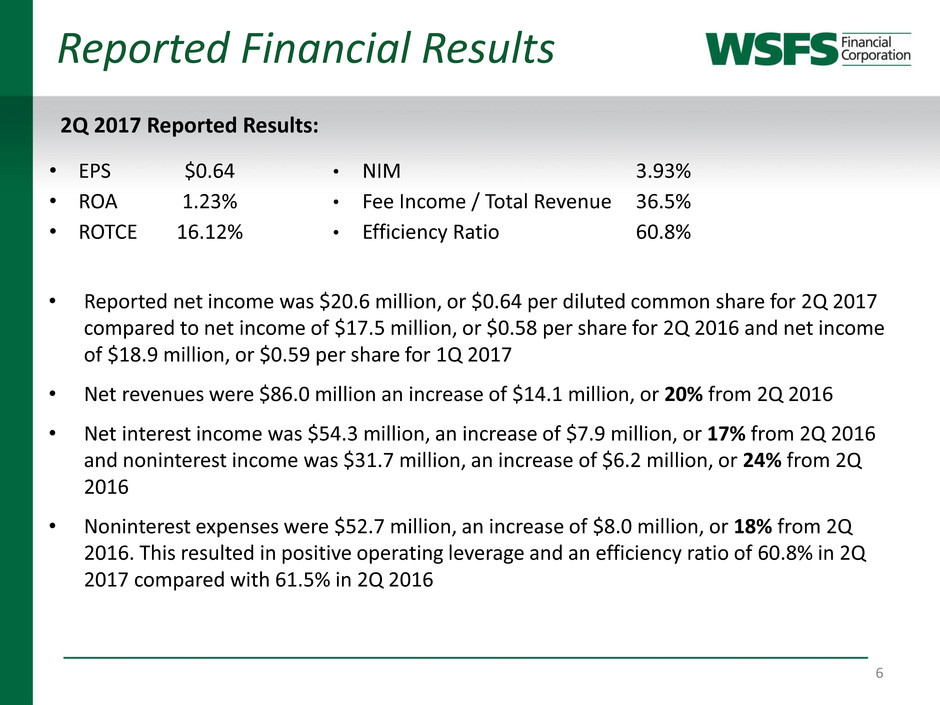
Reported Financial Results
6
2Q 2017 Reported Results:
• Reported net income was $20.6 million, or $0.64 per diluted common share for 2Q 2017
compared to net income of $17.5 million, or $0.58 per share for 2Q 2016 and net income
of $18.9 million, or $0.59 per share for 1Q 2017
• Net revenues were $86.0 million an increase of $14.1 million, or 20% from 2Q 2016
• Net interest income was $54.3 million, an increase of $7.9 million, or 17% from 2Q 2016
and noninterest income was $31.7 million, an increase of $6.2 million, or 24% from 2Q
2016
• Noninterest expenses were $52.7 million, an increase of $8.0 million, or 18% from 2Q
2016. This resulted in positive operating leverage and an efficiency ratio of 60.8% in 2Q
2017 compared with 61.5% in 2Q 2016
• EPS $0.64 • NIM 3.93%
• ROA 1.23% • Fee Income / Total Revenue 36.5%
• ROTCE 16.12% • Efficiency Ratio 60.8%

2Q 2017 Highlights

2Q 2017 Core (1) Results:
Strong Revenue Growth
Continued Expense Management
• Core(1) efficiency ratio of 60.9% in 2Q 2017 improved from 61.2% in 2Q 2016
• One percentage point of positive operating leverage
Loan Growth Continues
• Net loans increased $33.6 million, or 3% annualized, from 1Q 2017. These results were highlighted by 24%
(annualized) growth in consumer loans and 1% (annualized) growth in commercial loans
• Net loans increased $116.0 million, or 5% annualized, during the first six months of 2017
• EPS $0.63 • NIM 3.93%
• ROA 1.22% • Fee Income / Total Revenue 36.0%
• ROTCE 15.95% • Efficiency Ratio 60.9%
2Q 2017 Highlights
8 (1) These are non-GAAP financial measures and should be considered along with results prepared in accordance with GAAP, and not as a substitute for GAAP results. See Appendix 3 for
a reconciliation to GAAP financial information.
($ in millions) 2Q 2017 2Q 2016 Change
Core(1) Net Revenue $85.3 $71.4 +19% • Reflects strong organic and acquisition growth
Net Interest Income $54.3 $46.4 +17% • Reflects positive effects of both our combination with Penn Liberty
and higher short-term interest rates; offset by the additional 6bps
of senior debt cost (expect to use proceeds to pay off older, higher
cost debt in 3Q 2017) Net Interest Margin 3.93% 3.90% +3bps
Core(1) Fee Income $31.0 $25.0 +24% • Includes 13% organic growth

2Q 2017 Highlights
Customer Funding
• Total customer funding decreased $448.4 million from 1Q 2017. The decrease included the expected departure of
a short-term trust deposit of $352.4 million, $40.7 million of seasonal declines in public funding accounts and the
purposeful decrease of higher-cost CDs
• Core deposits increased $110.3 million, or 5% annualized, during the first six months of 2017
Credit Costs
• Total credit costs (provision for loan losses, loan workout expenses, OREO expenses, and other credit reserves)
were $2.3 million for 2Q 2017, a decrease from $2.8 million during 1Q 2017, and an increase from $1.3 million
during 2Q 2016
Asset Quality Trends Improve and Remain Favorable
• Total problem loans decreased to $161.7 million or 23.2% of Tier 1 Capital plus ALLL, compared to $184.0 million
or 27.1% at 3/31/17
• Delinquencies (including nonperforming delinquencies) were $23.9 million, a low 0.52% of gross loans, and a
slight decrease from $24.2 million and 0.53% of gross loans at 3/31/17
• Total NPAs to total assets were 0.86%, compared to 0.88% at 3/31/17. The past two quarters included the impact
of a $9.7 million locally-based C&I participation that was downgraded during 1Q 2017 after a targeted energy
sector review
• This loan relationship has been and continues to be current and well-secured; Positive resolution is expected
• Net charge offs were $1.7 million or only 0.15% of total net loans on an annualized basis and a decrease of $2.1
million or 0.19% (annualized) in 1Q 2017
9

2017 Outlook & 2016-2018 Strategic Plan
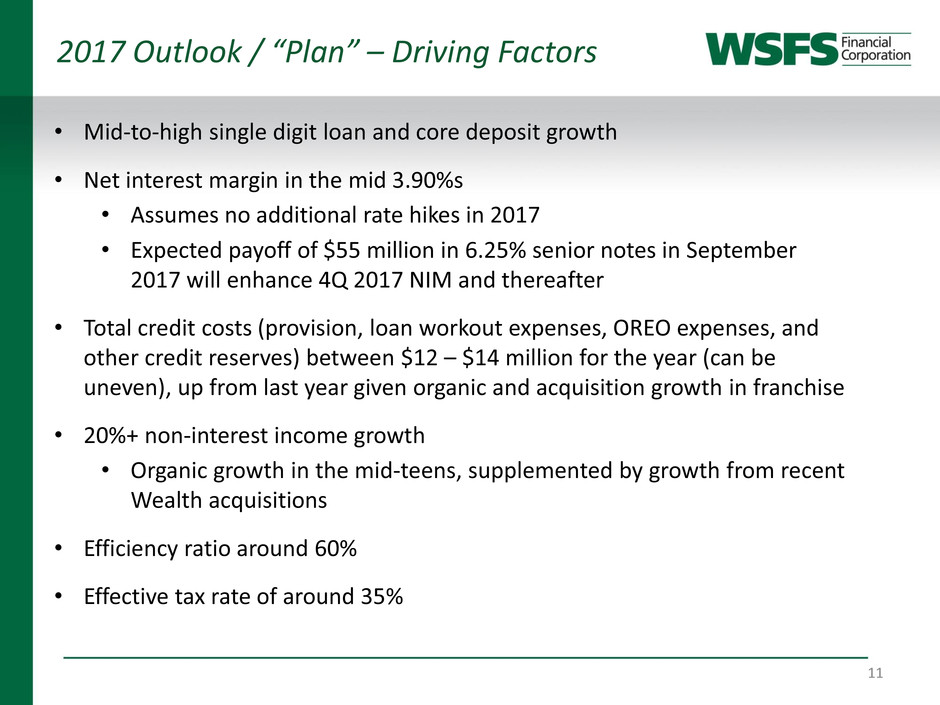
2017 Outlook / “Plan” – Driving Factors
11
• Mid-to-high single digit loan and core deposit growth
• Net interest margin in the mid 3.90%s
• Assumes no additional rate hikes in 2017
• Expected payoff of $55 million in 6.25% senior notes in September
2017 will enhance 4Q 2017 NIM and thereafter
• Total credit costs (provision, loan workout expenses, OREO expenses, and
other credit reserves) between $12 – $14 million for the year (can be
uneven), up from last year given organic and acquisition growth in franchise
• 20%+ non-interest income growth
• Organic growth in the mid-teens, supplemented by growth from recent
Wealth acquisitions
• Efficiency ratio around 60%
• Effective tax rate of around 35%

0.91%
0.95%
1.13% 1.15%
1.24%
0.80%
0.85%
0.90%
0.95%
1.00%
1.05%
1.10%
1.15%
1.20%
1.25%
FY13
Core &
Sustainable
FY14
Core &
Sustainable
FY15
Core &
Sustainable
FY16
Core &
Sustainable
FY17
Plan
12
Co
re
&
Su
st
ai
n
ab
le
(1
) R
O
A
Core & Sustainable ROA(1)
GAAP ROA 1.07% 1.17% 1.05% 1.06%
2017 Outlook
(1) Core and Sustainable ROA is a non-GAAP measure and should be considered along with results prepared with in accordance with GAAP, and not as a substitute for GAAP results.
See Appendix 3 for a reconciliation to GAAP financial information.

2016 – 2018 Strategic Plan
13
• Strong organic growth driven by favorable market demographics and
competitive disruption
• Selected acquisitions with a focus on increasing fee-based revenue
• Fee (non-interest) income to total revenue of 40% by 4Q 2018
• Positive operating leverage
• Mid-to-high single digit organic loan and deposit growth
• Low teens organic fee income growth
• Prudent expense management efficiency ratio ~60%
• Disciplined risk management NPAs < 1%
• Top quintile performance
• Core & Sustainable ROA of 1.30% by 4Q 2018

The WSFS Franchise
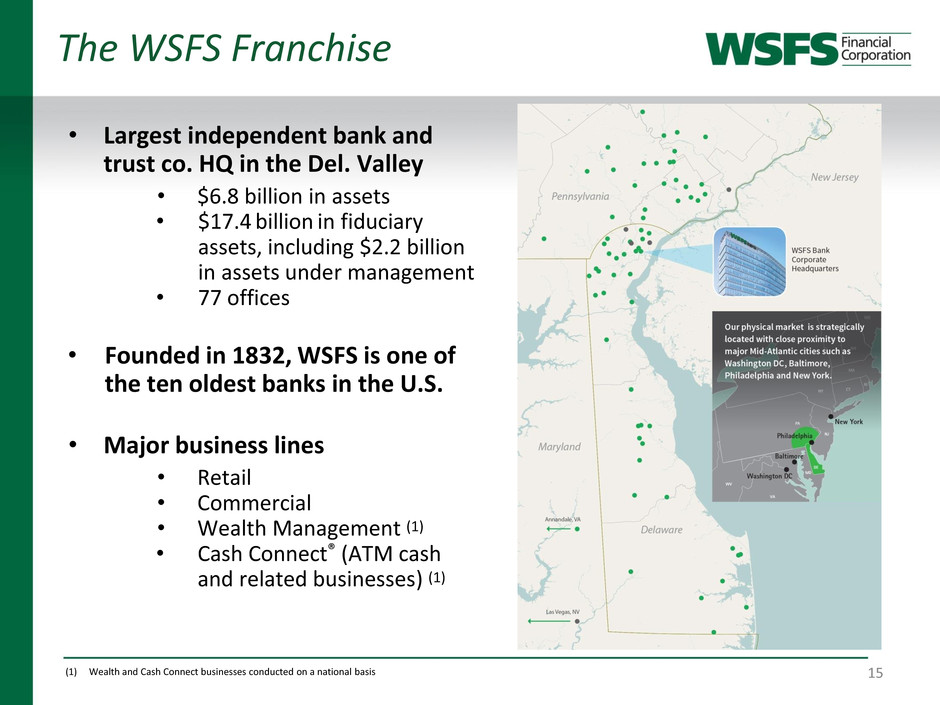
• Largest independent bank and
trust co. HQ in the Del. Valley
• $6.8 billion in assets
• $17.4 billion in fiduciary
assets, including $2.2 billion
in assets under management
• 77 offices
• Founded in 1832, WSFS is one of
the ten oldest banks in the U.S.
• Major business lines
• Retail
• Commercial
• Wealth Management (1)
• Cash Connect® (ATM cash
and related businesses) (1)
The WSFS Franchise
15 (1) Wealth and Cash Connect businesses conducted on a national basis

*Most recently available FDIC data 16
The WSFS Franchise - WSFS Bank
Deposits of Traditional Banks in the State of Delaware
June 30, 2016*
Rank
Institution
(Adjusted for M&A)
Branch
Count
Total
Deposits in
Market
Total
Market
Share
‘15-’16
Growth
‘15-’16
Growth
CAGR
‘08-’16
1 M&T Bank 39 5,767,847 28.85% 266,786 4.85% 2.44%
2 PNC Bank 39 4,083,312 20.43% 232,162 6.03% 6.70%
3 WSFS Bank 35 3,464,573 17.33% 254,450 7.93% 10.59%
4 Wells Fargo Bank 21 2,171,345 10.86% 140,084 6.90% -4.88%
5 Citizens Bank 23 1,119,400 5.60% 122,861 12.33% 1.09%
6 TD Bank1 13 981,306 4.91% (58,087) -5.59% 11.91%
7 Fulton Bank 10 522,251 2.61% 58,519 12.62% 8.98%
8 Artisans’ Bank 12 443,108 2.22% 14,062 3.28% -1.81%
9 County Bank 7 290,031 1.45% (11,348) -3.77% 0.11%
10 Bank of America 4 276,261 1.38% 28,066 11.31% 29.54%
Top 10 State of Delaware Banks2 203 $19,119,434 95.64% 1,047,555 5.80% 3.34%
(1) Excludes estimated out-of-market deposits of TD Bank
(2) Top 10 Delaware banks hold 96% of all traditional deposits in the state
Note: Credit Unions hold an additional $1.921B in deposits, including $398.6MM @ Dover FCU and $342.1MM @ Del-One FCU.
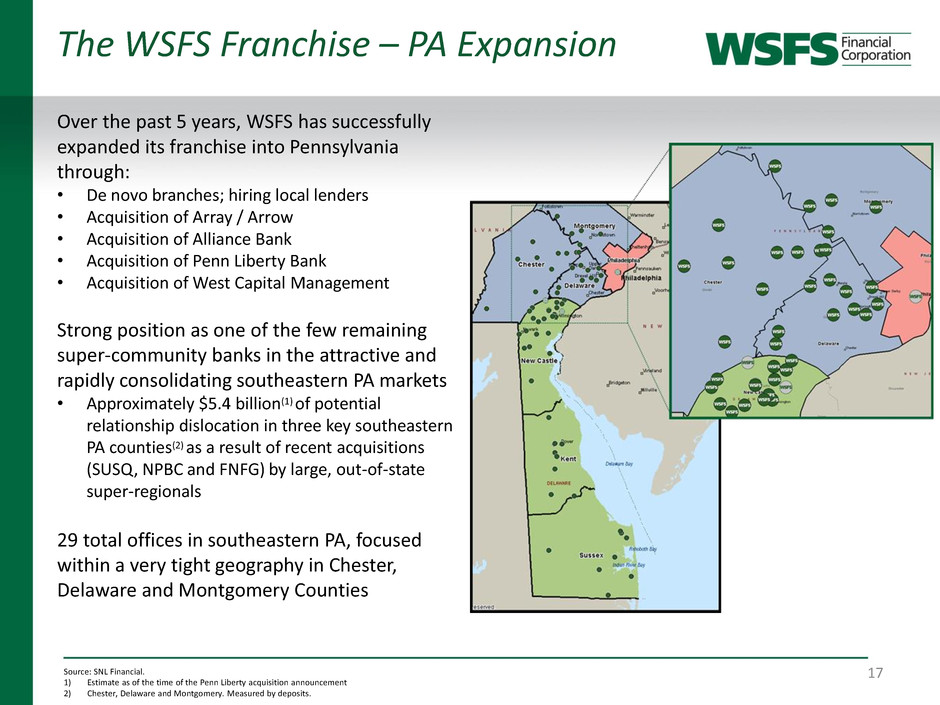
The WSFS Franchise – PA Expansion
17
Over the past 5 years, WSFS has successfully
expanded its franchise into Pennsylvania
through:
• De novo branches; hiring local lenders
• Acquisition of Array / Arrow
• Acquisition of Alliance Bank
• Acquisition of Penn Liberty Bank
• Acquisition of West Capital Management
Strong position as one of the few remaining
super-community banks in the attractive and
rapidly consolidating southeastern PA markets
• Approximately $5.4 billion(1) of potential
relationship dislocation in three key southeastern
PA counties(2) as a result of recent acquisitions
(SUSQ, NPBC and FNFG) by large, out-of-state
super-regionals
29 total offices in southeastern PA, focused
within a very tight geography in Chester,
Delaware and Montgomery Counties
Source: SNL Financial.
1) Estimate as of the time of the Penn Liberty acquisition announcement
2) Chester, Delaware and Montgomery. Measured by deposits.
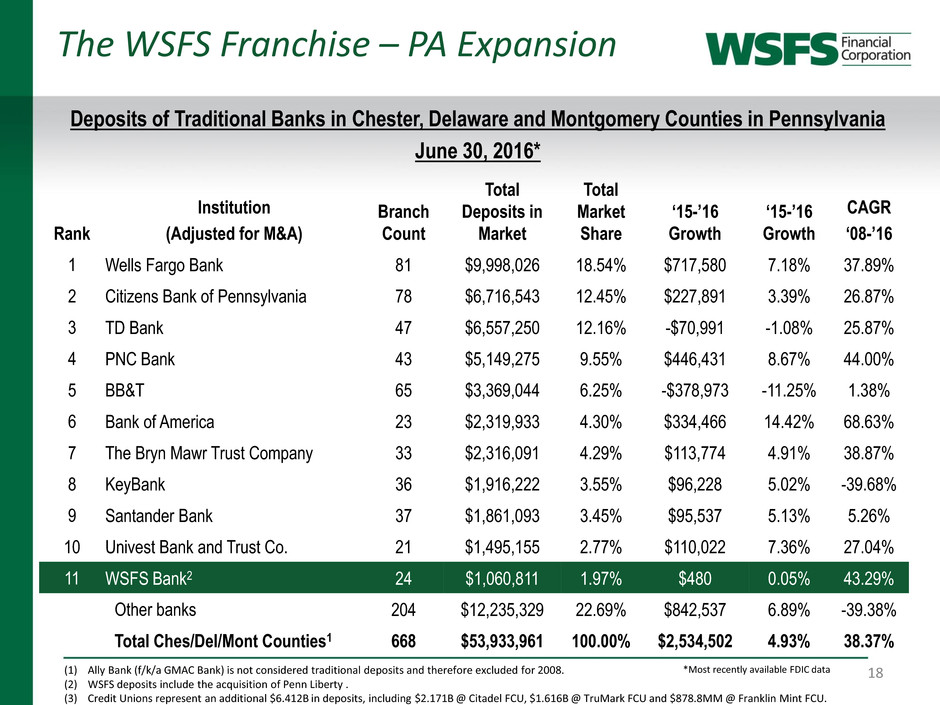
*Most recently available FDIC data 18 (1) Ally Bank (f/k/a GMAC Bank) is not considered traditional deposits and therefore excluded for 2008.
(2) WSFS deposits include the acquisition of Penn Liberty .
(3) Credit Unions represent an additional $6.412B in deposits, including $2.171B @ Citadel FCU, $1.616B @ TruMark FCU and $878.8MM @ Franklin Mint FCU.
Deposits of Traditional Banks in Chester, Delaware and Montgomery Counties in Pennsylvania
June 30, 2016*
Rank
Institution
(Adjusted for M&A)
Branch
Count
Total
Deposits in
Market
Total
Market
Share
‘15-’16
Growth
‘15-’16
Growth
CAGR
‘08-’16
1 Wells Fargo Bank 81 $9,998,026 18.54% $717,580 7.18% 37.89%
2 Citizens Bank of Pennsylvania 78 $6,716,543 12.45% $227,891 3.39% 26.87%
3 TD Bank 47 $6,557,250 12.16% -$70,991 -1.08% 25.87%
4 PNC Bank 43 $5,149,275 9.55% $446,431 8.67% 44.00%
5 BB&T 65 $3,369,044 6.25% -$378,973 -11.25% 1.38%
6 Bank of America 23 $2,319,933 4.30% $334,466 14.42% 68.63%
7 The Bryn Mawr Trust Company 33 $2,316,091 4.29% $113,774 4.91% 38.87%
8 KeyBank 36 $1,916,222 3.55% $96,228 5.02% -39.68%
9 Santander Bank 37 $1,861,093 3.45% $95,537 5.13% 5.26%
10 Univest Bank and Trust Co. 21 $1,495,155 2.77% $110,022 7.36% 27.04%
11 WSFS Bank2 24 $1,060,811 1.97% $480 0.05% 43.29%
Other banks 204 $12,235,329 22.69% $842,537 6.89% -39.38%
Total Ches/Del/Mont Counties1 668 $53,933,961 100.00% $2,534,502 4.93% 38.37%
The WSFS Franchise – PA Expansion
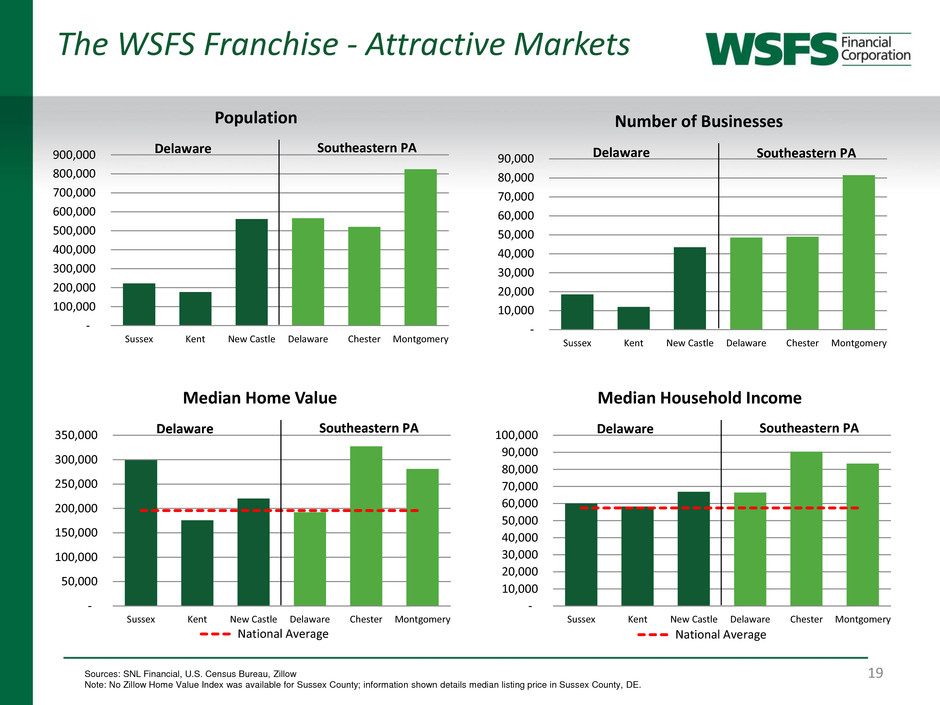
The WSFS Franchise - Attractive Markets
19 Sources: SNL Financial, U.S. Census Bureau, Zillow
Note: No Zillow Home Value Index was available for Sussex County; information shown details median listing price in Sussex County, DE.
-
100,000
200,000
300,000
400,000
500,000
600,000
700,000
800,000
900,000
Sussex Kent New Castle Delaware Chester Montgomery
Population
Delaware Southeastern PA
-
10,000
20,000
30,000
40,000
50,000
60,000
70,000
80,000
90,000
100,000
Sussex Kent New Castle Delaware Chester Montgomery
Median Household Income
National Average
Delaware Southeastern PA
-
50,000
100,000
150,000
200,000
250,000
300,000
350,000
Sussex Kent New Castle Delaware Chester Montgomery
Median Home Value
National Average
Delaware Southeastern PA
-
10,000
20,000
30,000
40,000
50,000
60,000
70,000
80,000
90,000
Sussex Kent New Castle Delaware Chester Montgomery
Number of Businesses
Delaware Southeastern PA

Regional Employment Composition
Philadelphia-Camden-Wilmington MSA
20 Source: Bureau of Labor Statistics: Employees on nonfarm payrolls by industry supersector, Philadelphia-Camden-Wilmington MSA, not seasonally adjusted; January 2017
Unemployment rate is for the Philadelphia-Camden-Wilmington MSA – preliminary March 2017
Mining, logging,
and construction
4% Manufacturing
6%
Trade, transportation,
and utilities
18%
Information
2%
Financial activities
7%
Professional and
business services
16%
Education and
health services
22%
Leisure and hospitality
9%
Other services
4%
Government
12%
Diversity of industries drives stable & favorable employment in our markets
Unemployment of 4.6%
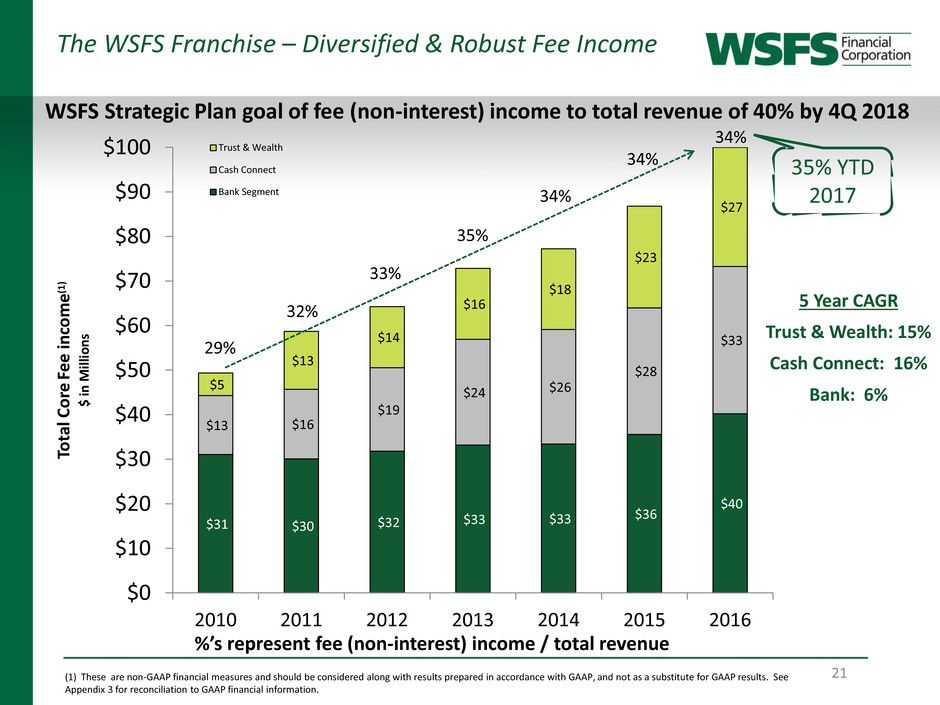
WSFS Strategic Plan goal of fee (non-interest) income to total revenue of 40% by 4Q 2018
$31 $30 $32 $33
$33 $36
$40
$13 $16
$19
$24 $26
$28
$33
$5
$13
$14
$16
$18
$23
$27
29%
32%
33%
35%
34%
34%
34%
$0
$10
$20
$30
$40
$50
$60
$70
$80
$90
$100
2010 2011 2012 2013 2014 2015 2016
To
ta
l Co
re
F
ee in
com
e
(1
)
$
in
Mi
ll
io
n
s
Trust & Wealth
Cash Connect
Bank Segment
The WSFS Franchise – Diversified & Robust Fee Income
21
%’s represent fee (non-interest) income / total revenue
(1) These are non-GAAP financial measures and should be considered along with results prepared in accordance with GAAP, and not as a substitute for GAAP results. See
Appendix 3 for reconciliation to GAAP financial information.
35% YTD
2017
5 Year CAGR
Trust & Wealth: 15%
Cash Connect: 16%
Bank: 6%

The WSFS Franchise – WSFS Wealth
A Full-Service Wealth Management Offering
22
Net Revenue of $12.7 million in 2Q 2017;
Pre-tax profit of $3.6 million

The WSFS Franchise – Cash Connect®
• Leading provider of ATM vault cash, armored carrier management, cash forecasting services,
insurance and equipment services
• More than $900 million in vault cash managed
• Over 21,000 non-bank ATMs in all 50 States
• Vault cash margin pressure offset by additional managed services
• Operates over 440 ATMs for WSFS Bank; largest in-market ATM franchise
• $9.1 million in net revenue (fee income less funding costs) and
$1.9 million in pre-tax profitability in 2Q 2017
• 5 year CAGR for net revenue is 16%
• Also serves as an innovation center for the company, both
expanding core ATM offerings and additional payment-, processing-
and software-related activities; e.g., launched WSFS Mobile Cash –
allows Customers to securely withdraw cash from ATMs by using
their WSFS Mobile Banking App
• Growing smart safe pipeline generated by several smart safe
distribution partners that are actively marketing our program, in
addition to over 1,000 smart safes as of 6/30/17, up from just over
100 safes at the end of 2015
23

Embracing Innovation as a Catalyst for Growth
24

Selected Financial Information
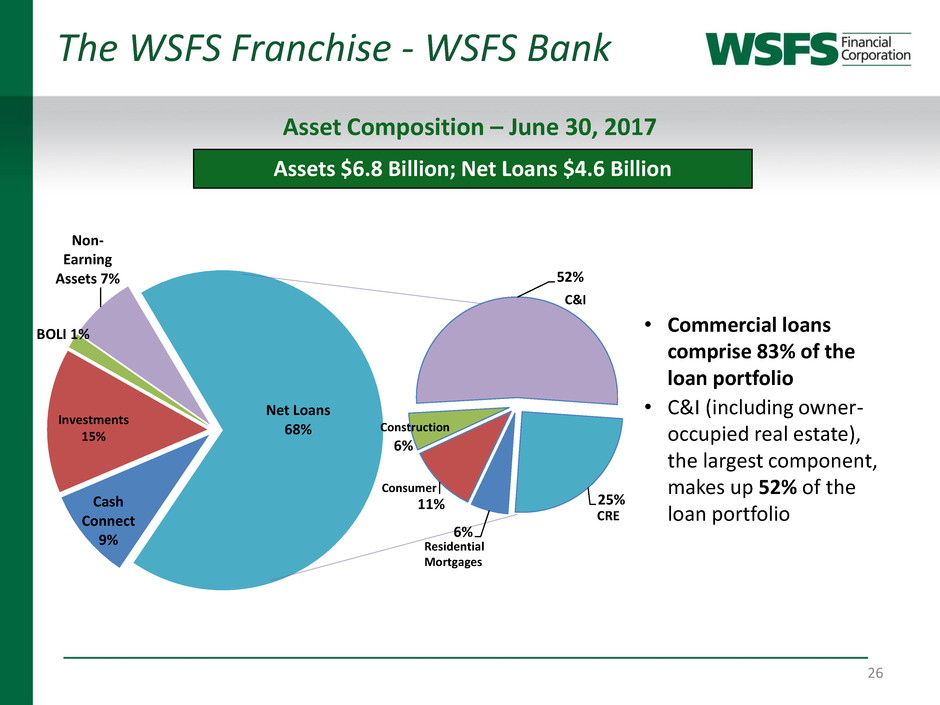
Cash
Connect
9%
Investments
15%
BOLI 1%
Non-
Earning
Assets 7%
Net Loans
68%
The WSFS Franchise - WSFS Bank
Assets $6.8 Billion; Net Loans $4.6 Billion
Asset Composition – June 30, 2017
6%
11%
6%
52%
25%
CRE
C&I
Residential
Mortgages
Consumer
Construction
• Commercial loans
comprise 83% of the
loan portfolio
• C&I (including owner-
occupied real estate),
the largest component,
makes up 52% of the
loan portfolio
26
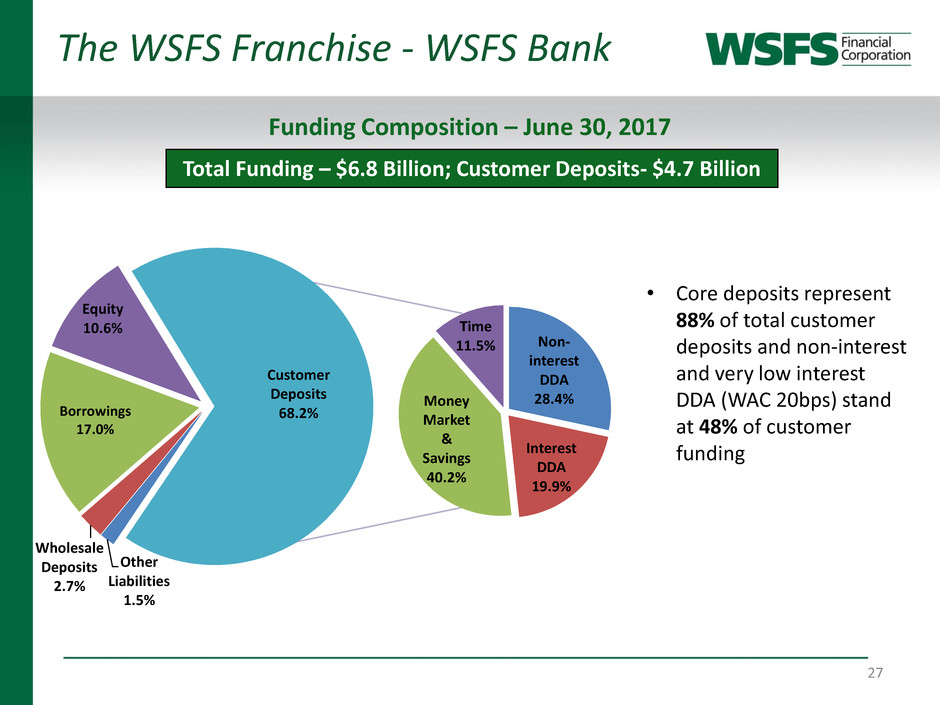
Total Funding – $6.8 Billion; Customer Deposits- $4.7 Billion
Funding Composition – June 30, 2017
Other
Liabilities
1.5%
Wholesale
Deposits
2.7%
Borrowings
17.0%
Equity
10.6%
Customer
Deposits
68.2%
Non-
interest
DDA
28.4%
Interest
DDA
19.9%
Money
Market
&
Savings
40.2%
Time
11.5%
• Core deposits represent
88% of total customer
deposits and non-interest
and very low interest
DDA (WAC 20bps) stand
at 48% of customer
funding
27
The WSFS Franchise - WSFS Bank

The WSFS Franchise - Balanced Growth
28
Balance sheet composition has remained steady as WSFS has grown
54%
52%
24%
25%
9%
6%
10%
11%
4%
6%
0
500,000
1,000,000
1,500,000
2,000,000
2,500,000
3,000,000
3,500,000
4,000,000
4,500,000
5,000,000
December 31, 2013 June 30, 2017
Loan Composition
C&I CRE
Residential Mortgage Consumer
Construction
8%
11%
25%
21%
14%
19%
14%
14%
28%
27%
10%
8%
0
1,000,000
2,000,000
3,000,000
4,000,000
5,000,000
6,000,000
7,000,000
8,000,000
December 31, 2013 June 30, 2017
Funding Composition
Equity Borrowings & Other
Non-Interest DDA Interest DDA
Money Market & Savings Time
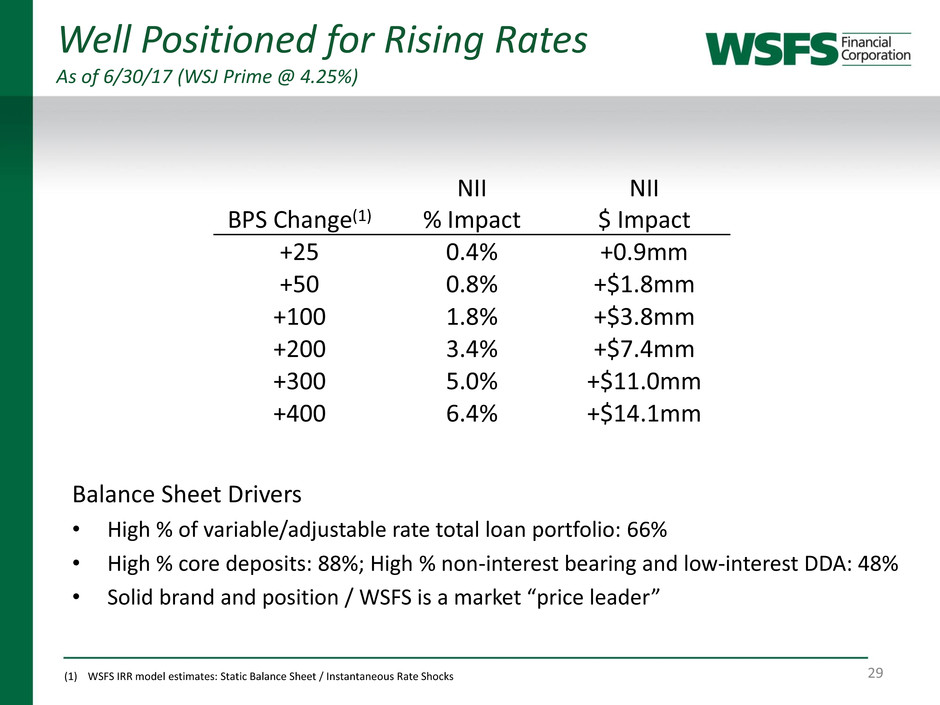
Well Positioned for Rising Rates
As of 6/30/17 (WSJ Prime @ 4.25%)
BPS Change(1)
NII
% Impact
NII
$ Impact
+25 0.4% +0.9mm
+50 0.8% +$1.8mm
+100 1.8% +$3.8mm
+200 3.4% +$7.4mm
+300 5.0% +$11.0mm
+400 6.4% +$14.1mm
Balance Sheet Drivers
• High % of variable/adjustable rate total loan portfolio: 66%
• High % core deposits: 88%; High % non-interest bearing and low-interest DDA: 48%
• Solid brand and position / WSFS is a market “price leader”
(1) WSFS IRR model estimates: Static Balance Sheet / Instantaneous Rate Shocks 29
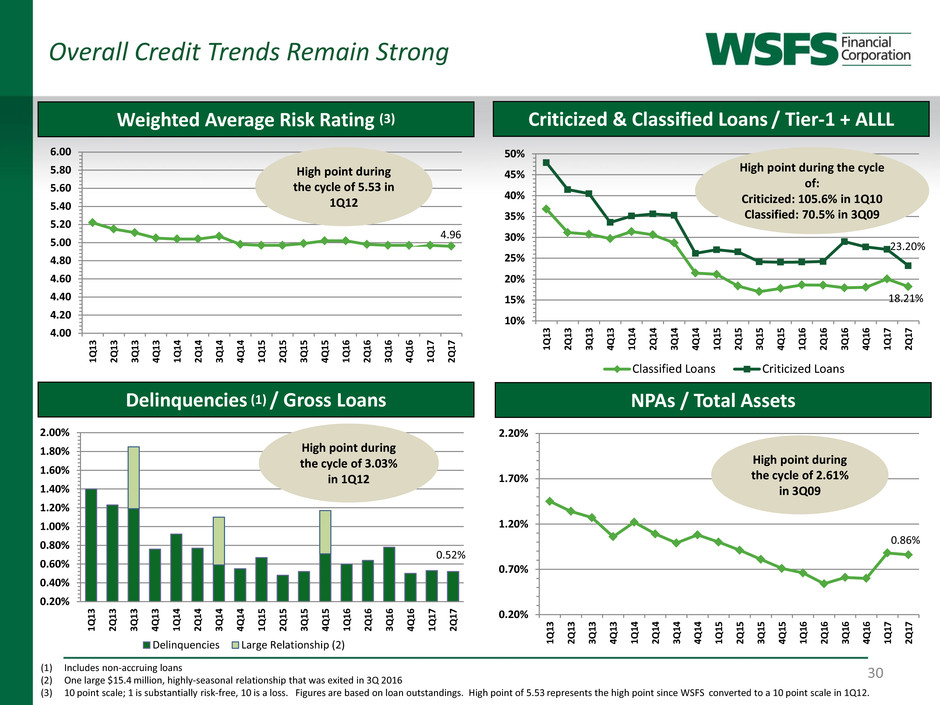
Overall Credit Trends Remain Strong
0.52%
0.20%
0.40%
0.60%
0.80%
1.00%
1.20%
1.40%
1.60%
1.80%
2.00%
1Q
13
2Q
13
3Q
13
4Q
13
1Q
14
2Q
14
3Q
14
4Q
14
1Q
15
2Q
15
3Q
15
4Q
15
1Q
16
2Q
16
3Q
16
4Q
16
1Q
17
2Q
17
Delinquencies Large Relationship (2)
Delinquencies (1) / Gross Loans
Weighted Average Risk Rating (3)
(1) Includes non-accruing loans
(2) One large $15.4 million, highly-seasonal relationship that was exited in 3Q 2016
(3) 10 point scale; 1 is substantially risk-free, 10 is a loss. Figures are based on loan outstandings. High point of 5.53 represents the high point since WSFS converted to a 10 point scale in 1Q12.
30
4.96
4.00
4.20
4.40
4.60
4.80
5.00
5.20
5.40
5.60
5.80
6.00
1Q
13
2Q
13
3Q
13
4Q
13
1Q
14
2Q
14
3Q
14
4Q
14
1Q
15
2Q
15
3Q
15
4Q
15
1Q
16
2Q
16
3Q
16
4Q
16
1Q
17
2Q
17
18.21%
23.20%
10%
15%
20%
25%
30%
35%
40%
45%
50%
1Q
13
2Q
13
3Q
13
4Q
13
1Q
14
2Q
14
3Q
14
4Q
14
1Q
15
2Q
15
3Q
15
4Q
15
1Q
16
2Q
16
3Q
16
4Q
16
1Q
17
2Q
17
Classified Loans Criticized Loans
Criticized & Classified Loans / Tier-1 + ALLL
NPAs / Total Assets
0.86%
0.20%
0.70%
1.20%
1.70%
2.20%
1Q
13
2Q
13
3Q
13
4Q
13
1Q
14
2Q
14
3Q
14
4Q
14
1Q
15
2Q
15
3Q
15
4Q
15
1Q
16
2Q
16
3Q
16
4Q
16
1Q
17
2Q
17
High point during
the cycle of 3.03%
in 1Q12
High point during
the cycle of 2.61%
in 3Q09
High point during
the cycle of 5.53 in
1Q12
High point during the cycle
of:
Criticized: 105.6% in 1Q10
Classified: 70.5% in 3Q09

Loan Portfolio Composition
Outstanding Balances as of 6/30/17
31
No industry or CRE concentrations in the loan portfolio
Commercial & Industrial: $1.32 billion
Owner Occupied CRE: $1.11billion
Top 25 Relationships ($): $526 million
Top 25 Relationships (% of C&I/OOCRE portfolio): 22%
Top 25 Relationships (% of commercial loans): 14%
Non Owner Occupied CRE $1.15 billion
Construction $280 million
Top 25 Relationships ($): $503 million
Top 25 Relationships (% of CRE portfolio): 35%
Top 25 Relationships (% of commercial loans): 13%
Real Estate Rental
and Leasing
8%
Other Services (except
Public Administration)
13%
Accommodation and
Food Services
11%
Retail Trade
10%
Health Care and Social
Assistance
9% Construction
8%
Manufacturing
8%
Wholesale Trade
7%
Other (13)
26%
C&I & Owner Occupied CRE
Mixed Use
3%
Flex, Warehouse, Self-
Storage, General
Industrial
12%
Office
22%
Retail
31%
Residential 1-4
16%
Residential Multi-
Family
13%
Special Use & Other
3%
CRE Investor & Construction
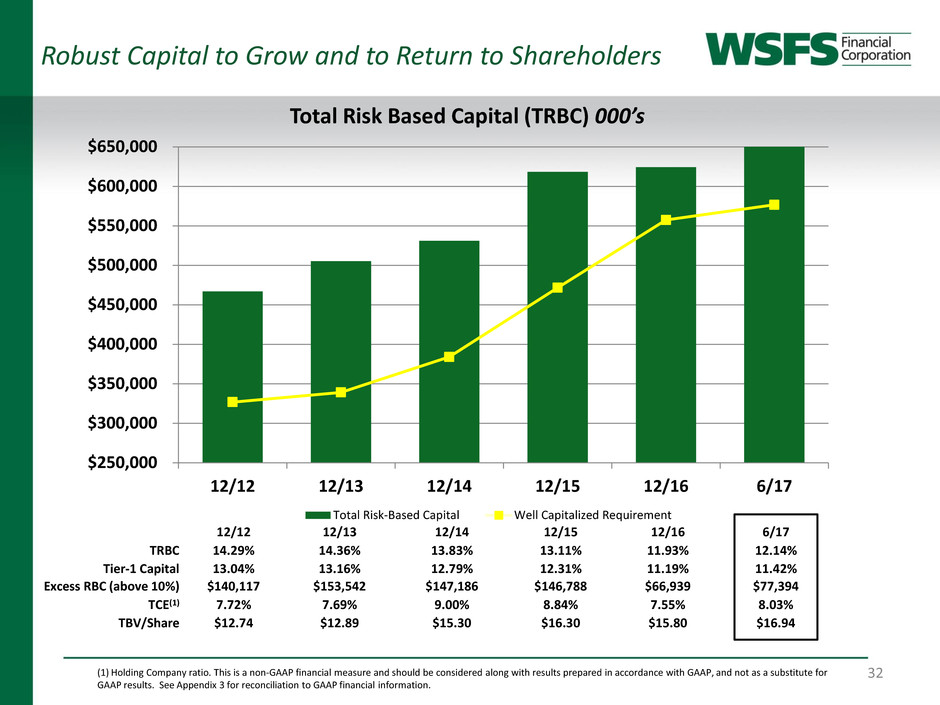
12/12 12/13 12/14 12/15 12/16 6/17
TRBC 14.29% 14.36% 13.83% 13.11% 11.93% 12.14%
Tier-1 Capital 13.04% 13.16% 12.79% 12.31% 11.19% 11.42%
Excess RBC (above 10%) $140,117 $153,542 $147,186 $146,788 $66,939 $77,394
TCE(1) 7.72% 7.69% 9.00% 8.84% 7.55% 8.03%
TBV/Share $12.74 $12.89 $15.30 $16.30 $15.80 $16.94
Robust Capital to Grow and to Return to Shareholders
$250,000
$300,000
$350,000
$400,000
$450,000
$500,000
$550,000
$600,000
$650,000
12/12 12/13 12/14 12/15 12/16 6/17
Total Risk-Based Capital Well Capitalized Requirement
Total Risk Based Capital (TRBC) 000’s
32 (1) Holding Company ratio. This is a non-GAAP financial measure and should be considered along with results prepared in accordance with GAAP, and not as a substitute for
GAAP results. See Appendix 3 for reconciliation to GAAP financial information.

Strong Alignment / Capital Management
• Executive management bonuses and equity awards based on bottom-line
performance
• ROA, ROTCE and EPS growth
• Insider ownership1 is over 5%
• Board of Directors and Executive Management ownership guidelines in place
and followed
• In 2Q 2017, WSFS repurchased 71,000 shares of common stock at an average price
of $45.18 as part of our 5% buyback program approved by the Board of Directors
in 4Q 2015
• 821,194 shares remaining to purchase under the current authorization
• $87.5 million in cash remains in the Holding Company as of 6/30/17
• The Board of Directors approved a quarterly cash dividend of $0.07 / share of
common stock. This will be paid on 8/25/17 to shareholders of record on 8/11/17
(1) As defined in our most recent proxy statement, as adjusted for unvested stock options approved by shareholders and awarded to the CEO and EVPs
in April 2013.
33
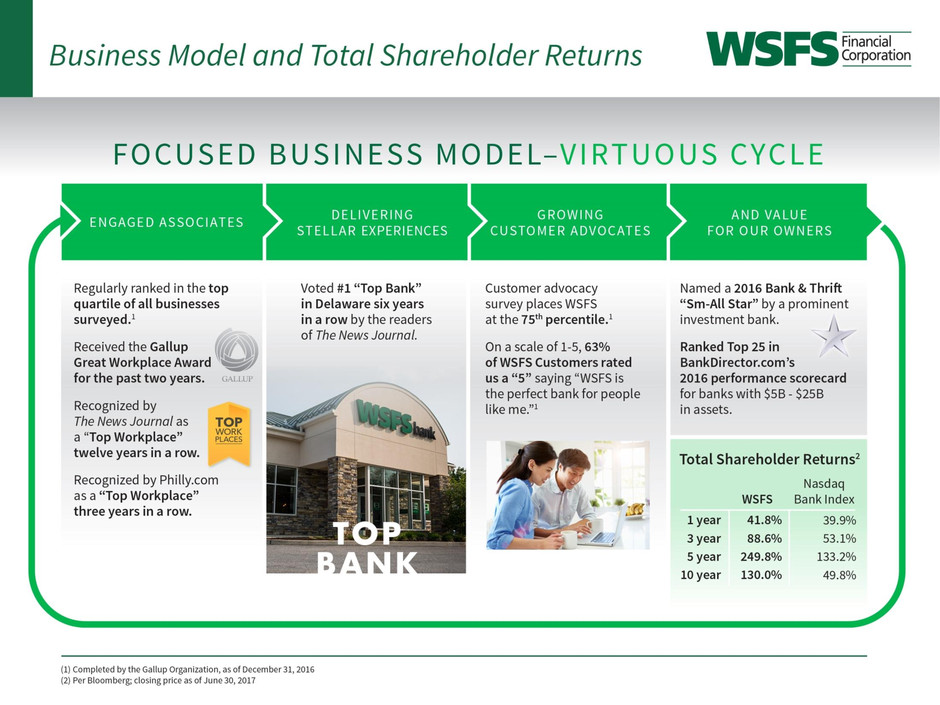
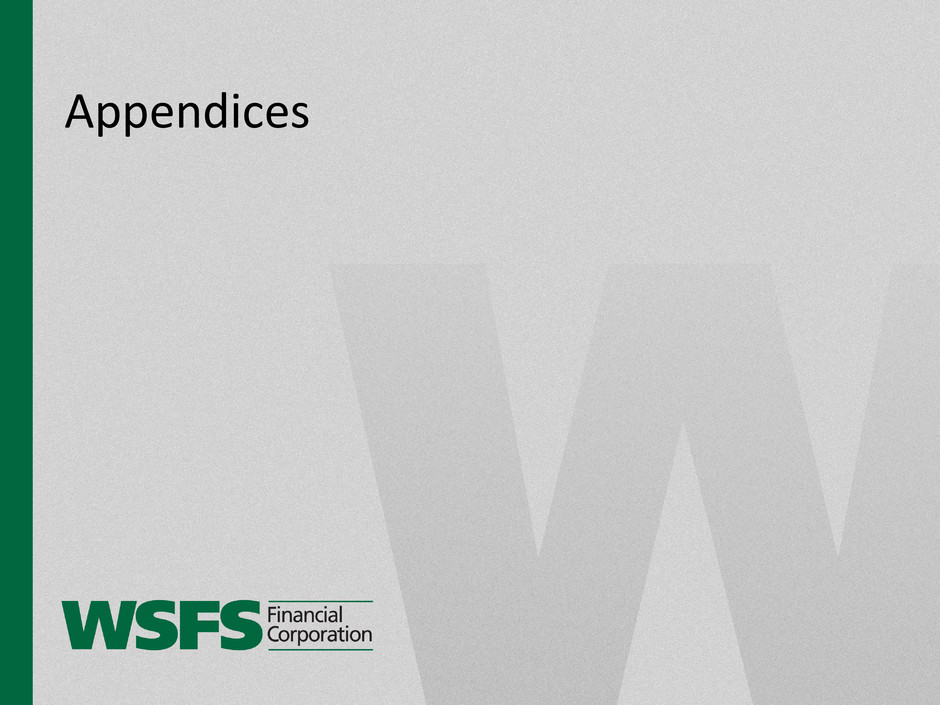
Appendices

Appendix 1 – Management Team
36
Mark A. Turner, 54, has served as President and Chief Executive Officer since 2007. He was elected Chairman of the
Board of Directors in July 2017. Mr. Turner was previously Chief Operating Officer and the Chief Financial Officer for
WSFS. Prior to joining WSFS, his experience includes working at CoreStates Bank and Meridian Bancorp. Mr. Turner
started his career at the international professional services firm of KPMG, LLP. He received his MBA from the Wharton
School of the University of Pennsylvania, his Masters Degree in Executive Leadership from the University of Nebraska
and his Bachelor’s Degree in Accounting and Management from LaSalle University.
Rodger Levenson, 56, Executive Vice President and Chief Operating Officer since July 2017. Mr. Levenson was
previously the Chief Commercial Banking Officer from 2006 to 2015, interim Chief Financial Officer from March 2015
to May 2016 and Chief Corporate Development Officer from May 2016 to July 2017. From 2003 to 2006, Mr. Levenson
was Senior Vice President and Manager of the Specialized Banking and Business Banking Divisions of Citizens
Bank. Mr. Levenson received his MBA in Finance from Drexel University and his Bachelor’s Degree in Finance from
Temple University.
Dominic C. Canuso, CFA, 42, recently joined WSFS as Executive Vice President and Chief Financial Officer. From 2006
to 2016, he was Finance Director at Barclays’ US Credit Card Business, most recently serving as Line of Business
CFO. Prior to Barclays, he was at Advanta Bank and Arthur Andersen Consulting. Mr. Canuso received his Executive
MBA and Bachelor’s Degree from Villanova University.
Steve Clark, 59, joined WSFS Bank in 2002 and has served as Executive Vice President and Chief Commercial Banking
Officer since May 2016. From 2002 thru 2006, Mr. Clark led and managed the establishment of the Middle Market
lending unit, and in 2007 became Division Manager of the Business Banking and Middle Market Divisions. Prior to
2002, he spent 23 years in various commercial banking positions at PNC Bank and its predecessor companies. Mr.
Clark received his MBA in Finance from Widener University and his Bachelor of Science Degree in Business
Administration (Marketing) from the University of Delaware.
Peggy H. Eddens, 61, Executive Vice President, Chief Human Capital Officer since 2007. From 2003 to 2007 she was
Senior Vice President for Human Resources and Development for NexTier Bank, Butler PA. Ms. Eddens received a
Master of Science Degree in Human Resource Management from La Roche College and her Bachelor of Science
Degree in Business Administration with minors in Management and Psychology from Robert Morris University.
Paul D. Geraghty, 63, Executive Vice President and Chief Wealth Officer since 2011. From 2007 to 2010, he was Chief
Executive Officer at Harleysville National Corporation, Harleysville, PA. Mr. Geraghty received his Bachelor of Science
in Accounting from Villanova University and pursued graduate study in business at Lehigh University.

Appendix 1 – Management Team
37
Paul S. Greenplate, 59, Executive Vice President and Chief Risk Officer, joined WSFS in 1999 and prior to his leadership
role in the Risk Division, he served as Senior Vice President and Treasurer. As Executive Vice President and Chief Risk
Officer, Mr. Greenplate oversees all independent Risk Management functions including, Credit Risk Management, Real
Estate Services, Asset Recovery, Enterprise Risk Management, Legal, Internal Audit, Loan Review and Regulatory
Compliance. Mr. Greenplate graduated from the University of Delaware with a Bachelor of Science in Economics.
Thomas W. Kearney, 69, Executive Vice President and Chief Risk Officer emeritus has been with WSFS since 1998. Mr.
Kearney holds a Bachelor’s degree in Business Administration (Finance and Accounting) from Drexel University. He
also holds the professional designations of Certified Bank Auditor (CBA) and Certified Financial Services Auditor
(CFSA).
S. James Mazarakis, 60, Executive Vice President and Chief Technology Officer since 2010. Mr. Mazarakis served in a
senior leadership role as Chief Information Officer for T. Rowe Price, and Managing Director and Divisional CIO at JP
Morgan Investment Asset Management. He received his Master of Science degree in Management of Technology from
Polytechnic Institute of New York University.
Thomas Stevenson, 64, has served as President of Cash Connect Division since 2003. Mr. Stevenson joined WSFS in
1996 as Executive Vice President and Chief Information Officer. Prior to joining WSFS, Mr. Stevenson was the
Manager of Quality Assurance at Electronic Payment Services. Mr. Stevenson attended Wayne State University and
the Banking and Financial Services program at the University of Michigan’s Graduate School of Business
Administration.
Patrick J. Ward, 61, joined WSFS in August 2016 as Executive Vice President, Pennsylvania Market President. He also
serves on the Board of Directors of WSFS Financial Corporation. Mr. Ward has over 32 years of banking industry
experience and previously served as Chairman and CEO of Penn Liberty Bank. He was an EVP of Citizens Bank of
Pennsylvania from January 2003 until January 2004. Prior thereto, Mr. Ward served as President and CEO of
Commonwealth Bancorp, Inc., the holding company for Commonwealth Bank, until its acquisition by Citizens Bank in
January 2003. Mr. Ward is a graduate of Carnegie Mellon University with a Bachelor of Science degree in economics
and earned an MBA from the University of Notre Dame.
Richard M. Wright, 64, Executive Vice President and Chief Retail Banking Officer since 2006. From 2003 to 2006, Mr.
Wright was Executive Vice President, Retail Banking and Marketing for DNB First in Downingtown, PA. Mr. Wright
received his MBA in Management Decision Systems from the University of Southern California and his Bachelor’s
Degree in Marketing and Economics from California State University.

Appendix 2 – Business Model
38

Appendix 3 – Non-GAAP Financial Information
Tangible common equity to assets and Tangible common book value per share
39
3 Months Ended 3 Months Ended 3 Months Ended
June 30, 2017 March 31, 2017 June 30, 2016
Total Assets $6,822,427 $6,852,899 $5,834,107
Less: Goodwill and other intangible assets $189,983 $190,372 $94,073
Total Tangible Assets $6,632,444 $6,662,527 $5,740,034
Total Stockholders Equity $722,623 $704,001 $617,196
Less: Goodwill and other intangible assets $189,983 $190,372 $94,073
Total Tangible Common Equity (non-GAAP) $532,640 $513,629 $523,123
Calculation of Tangible Common Book Value Per Share
Book Value per Share (GAAP) $22.99 $22.38 $20.89
Tangible Common Book Value Per Share (non-GAAP) $16.94 $16.33 $17.70
Calculation of Tangible Common Equity to Assets
Equity to Asset Ratio (GAAP) 10.59% 10.27% 10.58%
Tangible Common Equity to Asset Ratio (non-GAAP) 8.03% 7.71% 9.11%

Appendix 3 – Non-GAAP Financial Information
Core: GAAP Reconciliation
40 (1) Core Net Interest Income plus Core Non-interest Income. (2) Noninterest expense divided by (tax-equivalent) net interest income plus noninterest income . (3) Core noninterest
expense divided by (tax-equivalent) core net interest income plus core non interest income. (4) Non interest income divided by (tax equivalent) net interest income and non interest
income. (5) Core non interest income divided by (tax equivalent) core net interest income and core non interest income
3 Months Ended 3 Months Ended
30-Jun-17 30-Jun-16
Net Interest Income (GAAP) $54,314 $46,414
Adj:
Core Net Interest Income $54,314 $46,414
Noninterest Inc (as reported) $31,676 $25,507
Adj: Securities Gains ($708) ($545)
Core Non-interest Income $30,968 $24,962
Core Net Revenue (1) $85,282 $71,376
Tax equivalized interest (as reported) $718 $749
Noninterest Expense (GAAP) $52,727 $44,685
Adj: Corporate Development ($366) ($549)
Core Noninterest Expense $52,361 $44,136
Efficiency Ratio (Reported) (2) 60.8% 61.5%
Core Efficiency Ratio (3) 60.9% 61.2%
Fee Income / Total Revenue (4) 36.5% 35.1%
Core Fee Income / Total Revenue (5) 36.0% 34.6%
3 Months Ended
June 30, 2017
Net Income EPS ROA
Reported (GAAP) $20,570 $0.64 1.23%
Pre-tax adjustments: Sec
gains, corp. dev. costs, &
FHLB dividend
($342) ($0.01) (0.02%)
Tax inpact of adjustments $120 - 0.01%
Core (non-GAAP) $20,348 $0.63 1.22%
3 Months Ended
June 30, 2017
Total Average Stockholders' equity $713,781
Less: Goodwill and other intangible assets and preferred stock $190,125
Total Average Tangible Common Equity $523,656
Net Income (GAAP) $20,570
Less: Sec. gains, corp. dev. costs, net of taxes $222
Core Net Income (non-GAAP) $20,348
Plus Amortization of Goodwill and Other Intangibles $474
Core Total Tangible Net Income Allocable to Common Stockholders $20,822
Return on Tangible Common Equity (Reported) 16.12%
Core Return on Tangible Common Equity 15.95%

Appendix 3 -Non-GAAP Financial Information
Core: GAAP Reconciliation
41
FY16
Pre-Tax
Adjustments
FY16
FY15
Pre-Tax
Adjustments
FY15
FY14
Pre-Tax
Adjustments
FY14
FY13
Pre-Tax
Adjustments
FY13
FY12
Pre-Tax
Adjustments
FY12
FY11
Pre-Tax
Adjustments
FY11
Reported (GAAP) Net Income $64,079 $53,533 $53,757 $46,882 $31,311 $22,677
Adj: FHLB Dividend (808) (525)
Adj: Securities Gains (2,369) (1,528) (1,478) (961) (1,037) (674) (3,516) (2,285) (21,425) (13,926) (4,878) (3,171)
Adj: Rev mtg consol gain (3,801) (2,471)
Adj: BOLI Gain (1,006) (654)
Adj: Corp Development 8,529 5,828 7,620 5,469 4,031 2,741 717 538 3,662 2,454 780 507
Adj: Debt Extinguishment 651 423
Adj: Extraordinary tax benefit (6,604) (6,604)
Core Net Income $68,380 $57,940 $49,220 $42,664 $19,184 $20,013
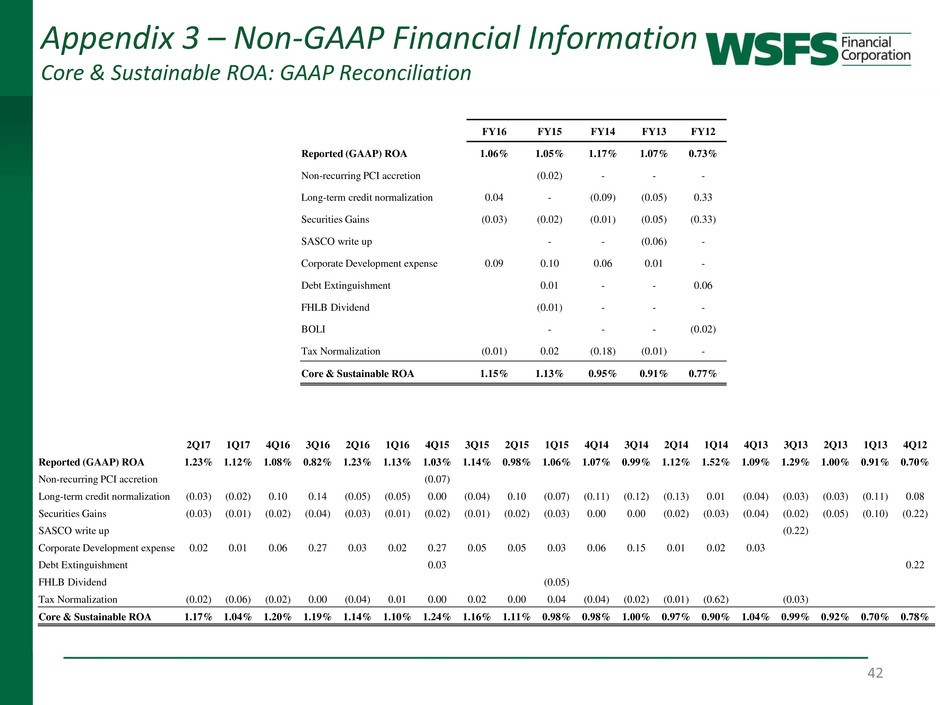
Appendix 3 – Non-GAAP Financial Information
Core & Sustainable ROA: GAAP Reconciliation
42
FY16 FY15 FY14 FY13 FY12
Reported (GAAP) ROA 1.06% 1.05% 1.17% 1.07% 0.73%
Non-recurring PCI accretion (0.02) - - -
Long-term credit normalization 0.04 - (0.09) (0.05) 0.33
Securities Gains (0.03) (0.02) (0.01) (0.05) (0.33)
SASCO write up - - (0.06) -
Corporate Development expense 0.09 0.10 0.06 0.01 -
Debt Extinguishment 0.01 - - 0.06
FHLB Dividend (0.01) - - -
BOLI - - - (0.02)
Tax Normalization (0.01) 0.02 (0.18) (0.01) -
Core & Sustainable ROA 1.15% 1.13% 0.95% 0.91% 0.77%
2Q17 1Q17 4Q16 3Q16 2Q16 1Q16 4Q15 3Q15 2Q15 1Q15 4Q14 3Q14 2Q14 1Q14 4Q13 3Q13 2Q13 1Q13 4Q12
Reported (GAAP) ROA 1.23% 1.12% 1.08% 0.82% 1.23% 1.13% 1.03% 1.14% 0.98% 1.06% 1.07% 0.99% 1.12% 1.52% 1.09% 1.29% 1.00% 0.91% 0.70%
Non-recurring PCI accretion (0.07)
Long-term credit normalization (0.03) (0.02) 0.10 0.14 (0.05) (0.05) 0.00 (0.04) 0.10 (0.07) (0.11) (0.12) (0.13) 0.01 (0.04) (0.03) (0.03) (0.11) 0.08
Securities Gains (0.03) (0.01) (0.02) (0.04) (0.03) (0.01) (0.02) (0.01) (0.02) (0.03) 0.00 0.00 (0.02) (0.03) (0.04) (0.02) (0.05) (0.10) (0.22)
SASCO write up (0.22)
Corporate Development expense 0.02 0.01 0.06 0.27 0.03 0.02 0.27 0.05 0.05 0.03 0.06 0.15 0.01 0.02 0.03
Debt Extinguishment 0.03 0.22
FHLB Dividend (0.05)
Tax Normalization (0.02) (0.06) (0.02) 0.00 (0.04) 0.01 0.00 0.02 0.00 0.04 (0.04) (0.02) (0.01) (0.62) (0.03)
Core & Sustainable ROA 1.17% 1.04% 1.20% 1.19% 1.14% 1.10% 1.24% 1.16% 1.11% 0.98% 0.98% 1.00% 0.97% 0.90% 1.04% 0.99% 0.92% 0.70% 0.78%

For more information please contact:
Investor Relations: Dominic Canuso (302) 571-6833 or
dcanuso@wsfsbank.com
www.wsfsbank.com
Corporate Headquarters
500 Delaware Avenue
Wilmington, DE 19801
43
